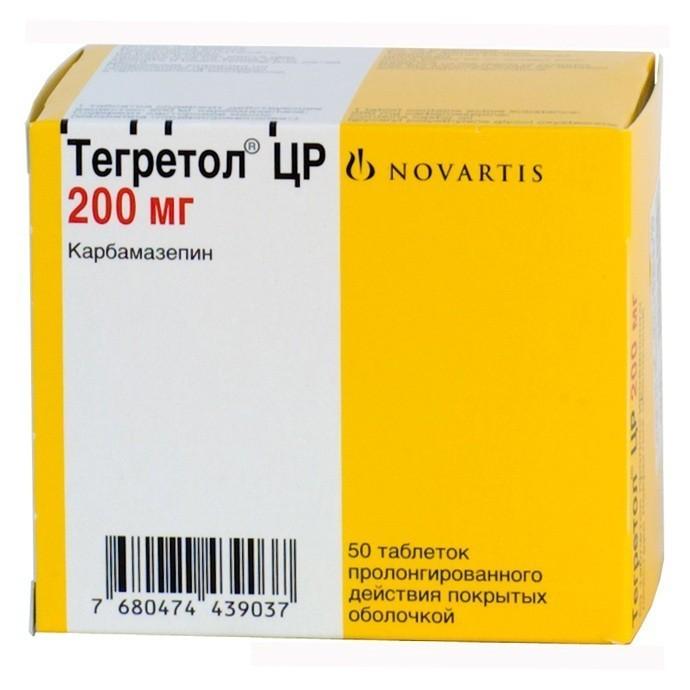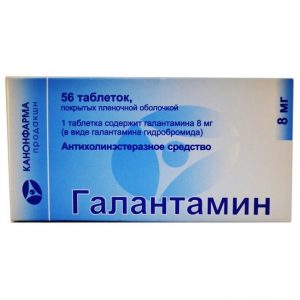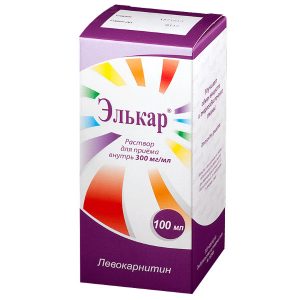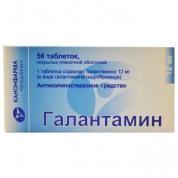Description
Latin name
Tegretol
Release form
Sustained-release tablets coated with a brick-orange coating, oval, slightly biconvex, with a risk on each side labeled HC on one side, CG on the other.
Packing
10 pcs. – blisters (5) – packs of cardboard.
Indications
epilepsy: complex or simple partial epileptic seizures (with or without loss of consciousness) with or without secondary generalization generalized tonic-clonic epileptic seizures mixed forms of epileptic seizures
acute manic conditions and supportive therapy of bipolar affective disorders in order to prevent exacerbations or mitigate clinical manifestations of exacerbation
alcohol withdrawal syndrome idiopathic trigeminal neuralgia and trigeminal neuralgia in scattering sclerosis (typical and atypical) idiopathic glossopharyngeal neuralgia
pain syndrome in diabetic neuropathy
polyuria and neurohormonal polydipsia with diabetes insipidus of central origin.
Contraindications
AV blockade
history of episodes of suppression of bone marrow hematopoiesis or information about acute intermittent porphyria
combination with MAO inhibitors (structural similarity with tricyclic antidepressants) chemical or drug sensitivity tricyclic antidepressants) or to other components of the drug.
Use in cases of impaired liver function
Before prescribing Tegretol and during treatment, it is necessary to study liver function, especially in patients who have a history of liver disease, as well as elderly patients. In the case of an increase in existing liver dysfunction or when an active liver disease occurs, Tegretol should be immediately canceled.
Use in cases of impaired renal function
For patients who have a history of kidney disease, the drug should be prescribed only after a careful analysis of the ratio of the expected treatment effect and the possible risk of therapy and with careful and regular monitoring.
Use during pregnancy and lactation
Treatment with Tegretol CR of epilepsy during pregnancy should be carried out with extreme caution.
In women of childbearing age, Tegretol CR should, as far as possible, be used as monotherapy, since the frequency of congenital anomalies of the fetus born to women who were treated with a combination of antiepileptic drugs is higher than for those who received each of these drugs as monotherapy.
The minimum effective dose of tegretol CR should be prescribed. Regular monitoring of the level of carbamazepine in blood plasma is recommended.
When a woman is pregnant, receiving Tegretol CR, or if there is a question about the appointment of Tegretol CR during pregnancy, it is necessary to carefully compare the expected benefits of therapy and its possible complications, especially in the first trimester of pregnancy.
It is known that children born to mothers with epilepsy are more likely than others to have intrauterine developmental disorders, including malformations. It has been reported that carbamazepine, like all major antiepileptic drugs, can increase the risk of these disorders, although there is still no definitive confirmation of this, which would have been obtained as a result of controlled studies using Tegretol CR as monotherapy. There are reports of cases of congenital diseases and malformations, including non-closure of the vertebral arches (spina bifida) and other congenital malformations (including craniofacial and cardiovascular systems) that were observed in patients taking Tegretol CR. Patients should be provided with information about the possibility of increasing the risk of malformations and the possibility of undergoing antenatal diagnosis.
Folic acid deficiency is known to develop during pregnancy. Antiepileptic drugs have been reported to exacerbate this deficiency. This can help increase the incidence of birth defects in children born to women taking antiepileptic drugs. Therefore, before and during pregnancy, an additional intake of folic acid is recommended.
In order to prevent increased bleeding in newborns in women in the last weeks of pregnancy, as well as newborns, vitamin K1 is recommended.
Carbamazepine is excreted in breast milk, the concentration in it is 25-60% of the level in blood plasma. Therefore, the benefits and possible undesirable consequences of breastfeeding should be compared in the context of ongoing therapy with Tegretol CR. Mothers taking Tegretol CR can continue breastfeeding, but provided that the baby is monitored for the development of possible side effects (for example, severe drowsiness, allergic skin reactions).
Several cases of epileptic seizures and / or respiratory depression have been described in newborns whose mothers took the drug simultaneously with other anticonvulsants. In addition, several cases of vomiting have also been reported, diarrhea and / or malnutrition in newborns whose mothers received Tegretol CR. Perhaps these reactions are manifestations of withdrawal syndrome in newborns.
Composition
1 tab.
carbamazepine 200 mg
Excipients: microcrystalline cellulose, carmellose sodium, polyacrylate dispersion 30% (Eudragit E 30 D), ethyl cellulose aqueous dispersion, talc, colloidal silicon dioxide anhydrous, magnesium stearate.
Shell composition: hypromellose, talc, titanium dioxide, castor oil (macrogol glycerylincinoleate), red iron oxide, yellow iron oxide.
Dosage and administration
The drug can be taken during, after meals or in between meals with a small amount of liquid.
The drug can be used both as monotherapy and as part of combination therapy.
Sustained-release tablets (a whole tablet or half, if prescribed by a doctor) should be swallowed whole without chewing, with a small amount of liquid. Because the active substance is released from slow-release tablets slowly and gradually, they are prescribed 2 times / day.
Given that Tegretol CR is prescribed 2 times / day, the optimal treatment regimen is determined by the doctor based on the above recommendations.
When transferring a patient from taking conventional tablets to taking extended-release tablets, clinical experience shows that in some patients, when using extended-release tablets, it may be necessary to increase the dose of the drug.
Considering drug interactions and the different pharmacokinetics of antiepileptic drugs, elderly patients should be selected with caution in the dose of Tegretol.
In cases of epilepsy when possible, Tegretol CR should be prescribed as monotherapy.
Treatment begins with a small daily dose, which is subsequently slowly increased until the optimal effect is achieved.
To select the optimal dose of the drug, it is recommended that the level of the active substance in the blood plasma be determined.
When Tegretol CR is added to other antiepileptic drugs taken, the dose of Tegretol CR is gradually increased. If necessary, carry out appropriate dose adjustment of the drugs.
For adults, the initial dose of Tegretol CR is 100-200 mg 1 or 2 times / day. Then the dose is slowly increased until the optimal therapeutic effect is achieved, usually it is achieved at a dose of 400 mg / day 2-3 times / day. Some patients may require a dose of Tegretol CR of 1.6 g / day or 2 g / day.
In children over 4 years of age, treatment can be started with the use of the drug at a dose of 100 mg / day, the dose is increased gradually – every week by 100 mg. In children under 3 years of age, carbamazepine is preferably used in the form of a syrup due to the difficulties of using solid dosage forms in this age group.
Supporting doses for children are 10-20 mg / kg / day (in several doses):
Child’s age Daily dose
4-5 years 200-400 mg
6-10 years 400-600 mg
11-15 years 600-1000 mg
trigeminal neuralgia, the initial dose of Tegretol CR is 200-400 mg / day. It is slowly increased until pain disappears (usually to a dose of 200 mg 3-4 times / day), and then gradually reduced to a minimum support. The recommended starting dose for elderly patients is 100 mg 2 times / day.
With alcohol withdrawal syndrome, the average dose is 200 mg 3 times / day. In severe cases, the dose may be increased during the first few days (for example, up to a dose of 400 mg 3 times / day). In severe manifestations of alcohol withdrawal, treatment begins with a combination of Tegretol CR with sedative-hypnotic drugs (for example, clomethiazole, chlordiazepoxide). After resolving the acute phase, treatment with Tegretol CR can be continued as monotherapy.
With polyuria and polydipsia of a neurohormonal nature, with diabetes insipidus of central origin, the average adult dose is 200 mg 2-3 times / day. In children, the dose should be reduced in accordance with the age and body weight of the child.
In pain syndrome with diabetic neuropathy, the average dose of Tegretol CR is 200 mg 2-4 times / day.
In acute manic conditions and the supportive treatment of affective (bipolar) disorders, daily doses are 400-1600 mg. The average daily dose is 400-600 mg (in 2-3 doses). In an acute manic state, the dose of Tegretol CR should be increased rather quickly. With maintenance therapy for bipolar disorders, in order to ensure optimal tolerance, each subsequent dose increase should be small, the daily dose increases gradually.
Side effects of
In assessing the frequency of occurrence of various adverse reactions, the following gradations were used: very often – 10% often – from 1% to
Certain types of side effects, for example, from the central nervous system (dizziness, headache, ataxia, drowsiness, general weakness, diplopia), gastrointestinal tract (nausea, vomiting) or allergic skin reactions, are found more or less often, especially at the beginning of treatment with Tegretol CR, when using too large an initial dose of the drug or in the treatment of elderly patients.
Dose-dependent side effects usually disappear within a few days, both spontaneously and after a temporary reduction in the dose of the drug. The development of side effects from the central nervous system may be due to relative overdose of the drug or significant fluctuations in the concentration of the active substance in the blood plasma. In such cases, it is recommended to monitor the level of active substance in the blood plasma.
From the mental side: rarely – hallucinations (visual or auditory), depression, loss of appetite, anxiety, aggressive behavior, agitation, disorientation very rarely – activation of psychosis.
From the side of the central nervous system and peripheral nervous system: very often – dizziness, ataxia, drowsiness, general weakness often – headache, diplopia, disturbances in accommodation (for example, blurred vision) sometimes – abnormal involuntary movements (for example, tremor, fluttering tremor / asterixis /, dystonia, tics), nystagmus rarely – orofacial dyskinesia, oculomotor disturbances, speech disorders (eg, dysarthria), choreoathetoid disorders, peripheral neuritis, paresthesias, muscle weakness and paresis symptoms.
The role of carbamazepine as a drug that causes or contributes to the development of malignant antipsychotic syndrome, especially when carbamazepine is prescribed together with antipsychotics, remains unclear.
Dermatological reactions: very rarely – photosensitivity, erythema multiforme and nodosum, skin pigmentation disorders, purpura, acne, increased sweating, hair loss. Rare cases of hirsutism have been reported, however, the causal relationship of this complication with the administration of Tegretol CR remains unclear.
Allergic reactions: very often – allergic skin reactions, urticaria, which can be significantly sometimes expressed – exfoliative dermatitis, erythroderma rarely – lupus-like syndrome, itching very rarely – Stevens-Johnson syndrome, toxic epidermal necrolysis (Lyell’s syndrome).
From the hemopoietic system: very often – leukopenia often – thrombocytopenia, eosinophilia rarely – leukocytosis, lymphadenopathy, folic acid deficiency very rarely – agranulocytosis, aplastic anemia, true red blood cell aplasia, megaloblastic anemia, peremosis, acute peremia.
Agranulocytosis and aplastic anemia may develop while taking the drug. However, due to the fact that these conditions are very rare, it is difficult to quantify the risk of their occurrence. It is known that the total risk of developing agranulocytosis in the general population that has not received treatment is 4.7 cases per 1 million people per year, and aplastic anemia – 2.0 cases per 1 million people per year.
From the liver: very often – increased levels of gamma-glutamyl transferase (due to the induction of this enzyme in the liver), which usually does not have clinical significance often – increased levels of alkaline phosphatase sometimes – increased levels of transaminases rarely – hepatitis of cholestatic, parenchymal (hepatocellular) or mixed type , jaundice is very rare – granulomatous hepatitis, liver failure.
From the gastrointestinal tract: very often – nausea, vomiting often – dry mouth sometimes – diarrhea or constipation, abdominal pain is very rare – glossitis, stomatitis, pancreatitis.
Hypersensitivity reactions: rarely – delayed-type multi-organ hypersensitivity with fever, skin rashes, vasculitis, lymphadenopathy, signs resembling lymphoma, arthralgia, leukopenia, eosinophilia, hepatosplenomegaly and altered liver function indicators (indicated manifestations) are found in various combinations. Other organs (e.g. lungs, kidneys, pancreas, heart, colon) may also be involved very rarely – aseptic meningitis with myoclonus and peripheral eosinophilia, anaphylactic reaction, angioedema.
If the above hypersensitivity reactions occur, the drug should be discontinued.
From the cardiovascular system: rarely – cardiac conduction disturbances, arterial hypertension or hypotension very rarely – bradycardia, arrhythmias, AV block with fainting, collapse, congestive heart failure, exacerbation of coronary heart disease, thrombophlebitis, thromboembolism.
From the endocrine system and metabolism: often – edema, fluid retention, weight gain, hyponatremia and decreased plasma osmolarity due to an effect similar to the action of antidiuretic hormone, which in rare cases leads to dilution hyponatremia, accompanied by lethargy, vomiting, headache disorientation and neurological disorders are very rare – increased prolactin levels, accompanied or not accompanied by manifestations such as galactorrhea, gynecomastia, changes in thyroid function indicators – a decrease in the level of L-thyroxine (FT4, T4, T3) and an increase in the level of thyroid-stimulating hormone, which is usually not accompanied by clinical manifestations of a violation of bone metabolism (a decrease in calcium and 25-OH-colecalciferol in blood plasma), which leads to osteomalacia in some cases – an increase in the concentration of cholesterol (Xc), including HDL-C, and triglycerides.
From the genitourinary system: very rarely – interstitial nephritis, renal failure, impaired renal function (e.g., albuminuria, hematuria, oliguria, increased urea / azotemia), rapid urination, urinary retention, sexual dysfunction / impotence.
From the sensory organs: very rarely – disturbances in taste, clouding of the lens, conjunctivitis of hearing impairment, including tinnitus, hyperacusia, hypoacusia, changes in perception of pitch.
From the musculoskeletal system: very rarely – arthralgia, muscle pain or cramps.
From the respiratory system: very rarely – hypersensitivity reactions from the lungs, characterized by fever, shortness of breath, pneumonitis or pneumonia.
Drug Interaction
The CYP3A4 isoenzyme is the major enzyme that provides carbamazepine-10,11-epoxide. Co-administration with Tegretol CR of CYP3A4 inhibitors can lead to increased plasma concentrations of carbamazepine, which in turn can cause side effects. Co-administration of CYP3A4 inducers may accelerate the metabolism of Tegretol CR and, thus, possibly reduce the concentration of carbamazepine in the plasma, and therefore possibly reduce the severity of the therapeutic effect. Withdrawal of concomitantly administered CYP3A4 inducers may reduce the rate of carbamazepine biotransformation and, as a consequence, lead to increased levels of carbamazepine in blood plasma.
Plasma carbamazepine levels may be increased by verapamil, diltiazem, dextropropoxyphene, viloxazine, fluoxetine, fluvoxamine possibly – cimetidine, acetazolamide, danazol, desipramine, nicotinamide (eg, high doses, maziocine, mazotropin , clarithromycin) azoles (eg, itraconazole, ketoconazole, fluconazole), terfenadine, loratadine, viral protease inhibitors (for HIV infection, for example, ritonavir). Because elevation of carbamazepine in the blood plasma can lead to side effects (such as dizziness, drowsiness, ataxia, diplopia), in these situations the dose of Tegretol CR should be corrected and / or the levels of carbamazepine in the blood plasma regularly examined.
Plasma carbamazepine levels may reduce phenobarbital, phenytoin, primidone, progabid or theophylline, metsuximide, fensuximide, rifampicin, cisplatin or doxorubicin, and although these data are partially contradictory, clonazepine may also be (Hypericum perforatum). On the other hand, there are reports that valproic acid, valpromide, and primidone increase the plasma concentration of a pharmacologically active metabolite, carbamazepine-10,11-epoxide. Therefore, dose adjustment of Tegretol CR may be required.
When co-administered with felbamate, a decrease in serum carbamazepine may be associated with an increase in carbamazepine epoxide, thus, a decrease in the serum concentration of felbamate is possible.
It is reported that isotretinoin alters the bioavailability and / or clearance of carbamazepine and carbamazepine-10,11-epoxide in this case monitoring of carbamazepine plasma concentration is required.
Carbamazepine may reduce plasma concentrations or reduce or even completely offset the effects of some drugs. Dose adjustments of the following drugs may be required: clobazam, clonazepam, etosuximide, primidone, valproic acid, alprazolam corticosteroids (eg, prednisolone, dexamethasone) cyclosporine, digoxin, doxycycline, felodipine, haloperidol, haloperidol, haloperidol ), theophylline, oral anticoagulants (warfarin, phenprocoumon, dicumarol), felbamate, lamotrigine, zonisamide, tiagabine, topiramate, tricyclic antidepressants (eg imipramine, amitriptyline, nortriptyline, clomipramine), clozapine, oxcarbazepine, protease inhibitors used in the treatment of HIV infection (indinavir, ritonavir, ritonavir, felodipine), itraconazole, levothyroxine, midazolam, olanzapine, preparations containing estrogens and / or progesterone, praziquantel, risperidone, tramadol, cyprasidone.
There are reports that, while taking carbamazepine, the level of phenytoin in the blood plasma can both rise and fall, and the level of mefenitoin may rise (in rare cases).
When combined with carbamazepine and paracetamol (acetaminophen), the latter’s bioavailability may be reduced.
Hepatotoxicity enhancement reports are known, caused by isoniazid, when used concomitantly with carbamazepine.
The combined use of carbamazepine and lithium or metoclopramide, as well as carbamazepine and neuroleptics (haloperidol, thioridazine) can lead to an increase in the frequency of adverse neurological reactions (in the case of the latter combination – even at therapeutic concentrations of active substances).
The concomitant use of Tegretol CR with some diuretic agents (hydrochlorothiazide, furosemide) can lead to hyponatremia, which is accompanied by clinical manifestations.
Carbamazepine may be antagonistic to the action of non-depolarizing muscle relaxants (eg, pancuronium). If such a combination of medicines is used, it may be necessary to increase the dose of these muscle relaxants, and close monitoring of patients should be performed as soon as the cessation of muscle relaxants is expected.
It has been reported that women have bleeding between menstrual periods when oral contraceptives are used at the same time. The drug may reduce the therapeutic effect of oral contraceptives due to the induction of microsomal enzymes.
Carbamazepine, like other psychotropic agents, can reduce alcohol tolerance. In this regard, the patient is advised to refuse alcohol.
Co-administration with grapefruit juice may increase carbamazepine plasma levels.
Overdose
Overdose is usually manifested by symptoms from the CNS, cardiovascular and respiratory systems.
symptoms Central nervous system: CNS depression, disorientation, drowsiness, arousal, hallucinations, coma blurred vision, indistinct speech, dysarthria, nystagmus, ataxia, dyskinesia, hyperreflexia (initially), hyporeflexia (initially) , mydriasis.
Respiratory system: respiratory depression, pulmonary edema.
Cardiovascular system: tachycardia, hypotension sometimes – arterial hypertension, conduction abnormalities with expansion of the QRS complex cardiac arrest, fainting caused by cardiac arrest. gastrointestinal tract: vomiting, delayed passage of food from the stomach, decreased motility of the colon.
Urinary system: Urinary retention, oliguria or anuria fluid retention of hyponatremia dilution due to the effect of carbamazepine, similar to the action of antidiuretic hormone.
Changes from laboratory parameters: hyponatremia, metabolic acidosis is possible, hyperglycemia is possible, increase in muscle fraction of creatinine phosphokinase.
Treatment
Initially, treatment should be based on the patient’s clinical condition showing hospitalization. The concentration of carbamazepine in the plasma is determined to confirm the poisoning by this agent and to assess the degree of overdose.
Evacuation of gastric contents, gastric lavage, activated charcoal is carried out. Late evacuation of gastric contents may result in delayed absorption and recurrence of intoxication symptoms during recovery. Applied symptomatic supportive therapy in the intensive care unit, monitoring of cardiac function, careful correction of electrolyte disorders.
Special Recommendations
When developing hypotension shown in / in the introduction of dopamine or dobutamine in the development of heart rhythm disorders, treatment is selected individually for the development of convulsions – the introduction of benzodiazepines, such as diazepam or other anticonvulsants, such as phenobarbital (with caution due to increased respiratory depression), or paraldehyde in the development of hyponatremia (water intoxication) – restriction of fluid administration and cautious administration of 0.9% sodium chloride solution, which may help prevent brain damage. Hemosorption on coal sorbents is recommended. Inefficiency of forced diuresis, hemodialysis, and peritoneal dialysis have been reported. It is possible to intensify the symptoms of overdose on the 2nd and 3rd day after its onset, which is due to the slow absorption of carbamazepine.
Storage conditions
The drug should be stored in a dry place inaccessible to children at a temperature not exceeding 25 ° C.
Expiration
3 years.
Deystvuyuschee substances
Carbamazepine
Dosage form
Dosage form
tablets prolong.
Novartis Farma Stein AG, Switzerland




